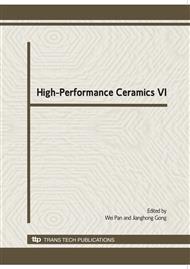p.193
p.197
p.202
p.205
p.209
p.214
p.217
p.221
p.224
Comparison and Relative Error of Elastic Modulus in Glass Measured by Three Test Techniques
Abstract:
Elastic modulus of glass was measured using static method, dynamic method and Vickers indentation technique, respectively. The residual indent of Vickers indentation is analyzed to estimate the elastic modulus, using conventional hardness tester without load-depth curve. The modulus and hardness of glass are determined by load, deformation and residual semi-angle of the indent. The result is compared with the modulus obtained by conventional dynamic and static methods. It was shown that the modulus measured by dynamic method provides the highest value and the modulus obtained by indentation technique is between the values of dynamic modulus and static modulus. The result also shows that the modulus measured by dynamic method has very stable value and that measured by bending method has the lowest value. The modulus obtained in indentation tests shows relatively greater scatter.
Info:
Periodical:
Pages:
209-213
Citation:
Online since:
March 2010
Authors:
Keywords:
Price:
Сopyright:
© 2010 Trans Tech Publications Ltd. All Rights Reserved
Share:
Citation:


